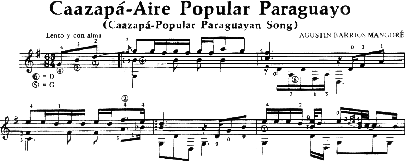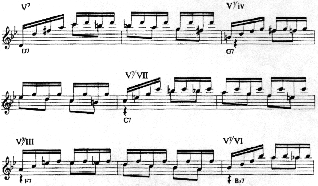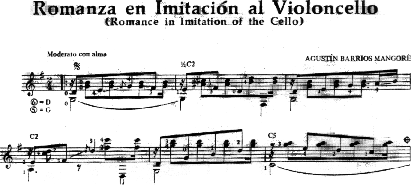Agustín Barrios Mangore:The Folkloric, Imitative, and the Religious Influence Behind His Compositions by Johnna Jeong

|
Agustín Barrios Mangoré:The Folkloric, Imitative, and the Religious Influence Behind His Compositionsby Johnna Jeong |
"... as a guitarist/composer, Barrios is the best of the lot, regardless of ear. His music is better formed, it's more poetic, it's more everything! And it's more of all those things in a timeless way. So I think he's a more significant composer than Sor or Guiliani, and more significant composer --- for the guitar --- than Villa-Lobos."
"Agustín Barrios Mangoré (b. May 5, 1885, d. August 7, 1944) was the greatest guitarist/composer of the first half of the present century." 2 Barrios was born into a large family in the small town of San Bautista de las Misiones, in Southern Paraguay, the fifth of seven sons. Both of his parents were educators and both placed great value on culture and arts. Inspired by his mother's guitar playing, Barrios began to play the guitar at a very young age.
Through the folk music of his native country, young Barrios received his first introduction to music; with songs such as the polca paraguaya, vals , and the zamba. In 1898, Barrios was formally introduced to the classical guitar repertoire by Gustovo Sosa Escalada. At that time, young Barrios had already composed works for the guitar, and also performed pieces written by his former teacher Alias, such as: La Chinita and La Perezosa. Under the influence of his new teacher, Barrios went on to perform and study the works of Tarraga, Vinas, Sor and Aguado. Sosa Escalada was so impressed with his new pupil, that he convinced Barrios' parents to let him move to Ascuncion to continue his education. 3 Having already surpassed the technical and performing abilities of most guitarists, Barrios began to seriously compose around 1905.
Three essential categories revealed in Barrios' compositions are folkloric, imitative, and religious. Barrios honored the music and the people of his native land and composed pieces modeled after folkloric songs of various countries of South America. Imitating composition and techniques form the Baroque and Romantic periods was another side to his craftsmanship. La Cathedral may be viewed upon as Barrios' imitation of Bach counterpoint. It is believed that La Cathedral was inspired by what may have been a religious experience for Barrios; therefore, the piece may also be categorized under religion. Religious beliefs and experiences also played an important role in Barrios' compositional process. Una limosna por el amor do Dio (An Alm for the Love of God), is another example of a religious inspired work. Breaking down the works of Barrios into these three categories helps aid the guitar enthusiast in the understanding of Barrios' musical intent.
Folkloric Aspects
The music of Barrios is reflective of many aspects of his life. He took great pride in his homeland, and many of his compositions were modeled after folkloric songs of various countries in South America. For example: he composed Choros, which is a from out of Rio de Janerio; Tangos originating in Argentina, Cuecos originating in Chile, and Danza Paraguayas, from Paraguay. Among his folkloric compositions, there are various regional dances; Danza Paraguaya No. 1 (c 1924), Danza Paraguaya No.2; Jha, Che Valle!, (c. 1923), and Danza Paraguaya No.3: London Carapé (c. 1909) exhibit some of his folkloric tributes to Paraguay. These three dances are based on Paraguayan rhythms and themes. The texture of Danza Paraguaya No.1 and No.2 is imitative of the Paraguayan folk harp. Folk harp music traditionally employs the galopa rhythm (Ex.1), and it is this rhythm that Barrios applies in Danzas No.1 and No.2. Jha Che Valle! (Danza Paraguaya No.2), is a phrase in the Guarani tongue (which is spoken more widely in Paraguay than Spanish) and means "Oh my homeland!" London Carapé (Little London), is a reference to nineteenth-century Asució. These lively pieces show yet another side to Barrios' multi-faceted musical personality. 4
Ex. 1: galopa (traditional Paraguayan rhythm): 5

Another example of how Barrios utilized rhythmic ideas of his native country is clearly illustrated in Caazapá is typical of Latin American music of Hispanic derivation. The meter alternates between 6/8 and 3/4 time, and occasionally moves toward polyrhythmic activity.
Ex 2: Illustration of a Paraguayan Popular Song and its alternation between 6/8 and 3/4:6

Imitative Abilities
Barrios' abilities did not only introduce his personal and innovative style, but he was also a master at imitating various eras and composers. "Barrios' compositional approach was eclectic, combining forms and harmonic devices from the Baroque, Classical and Romantic eras; often integrating them with popular forms and rhythms." 7 His music illustrates Romantic and Impressionistic characteristics, exampled by Un Sueno en la Floresta. This piece is a Romantic tremolo piece written in 1918, which expands the boundaries of tremolo composition with its intricate movement of inner voices and left-hand extension. To play this piece, Barrios had guitars made with an additional twentieth fret to accommodate the high C on the first string. Although common in today's guitar literature, this high C was unheard of prior to Barrios' work. 8
By 1919, while still in Brazil he composed Romanza en Imitació al Violoncello, Estudio de Concierto, Mazurka Apasionata, and Allegro Sinfónico. Analyzing the classics and transcribing for the guitar the works of Bach, Beethoven, Chopin, and Schumann, exerted a very strong influence upon his compositions during this time.
Barrios had a great love for the music of J. S. Bach. He had once stated, "How well Bach elevates us to the eternal".9 Many of his concerts consisted of his own transcriptions of the music of Bach. Transcribing the music of Bach for the guitar aided in his better understanding of the harmonic function of the pieces, and thus greater ability to compose in the style of Bach was attained. His Preludio Op. 5, No. 1 (in g minor) is an homage to Bach written in a baroque-like prelude form, making use of the concept of the pedal as illustrated in example 3. Barrios has successfully mastered the craft of imitating the music of J. S. Bach. The music of Bach, was written for instruments such as the cello, keyboard and lute and must be transcribed to the guitar, thus creating certain idiomatic problems. The one advantage of playing the music of Barrios, which was modeled after Bach, is that the music fits the guitar in a more comfortable manner. The music is written for the guitar, by a guitarist, and therefore is more attainable.
Ex. 3: Preludio ms. 72-80: 10

Barrios was fortunate to have studied the Aguado and Sor methodologies in his early years of training. Around 1917, he discovered the music of Tárrega and thereafter he began composing some of his best works. Some years later, Barrios wrote Variations on a Theme of Tárrega. "This work is undoubtedly one of the most technically demanding pieces. It explores many areas of guitar technique; arpeggios, scales, slurring, harmonics and tremolo. Paying homage to Tárrega's Lágrima, it consists of six variations that demonstrate Barrios' mastery of guitar technique and composition." 11 This piece portrays his most mature writing.
A standard piece in guitar repertoire is Prelude No. 1 in e minor by Heitor Villa-Lobos. This piece presents the melody primarily in the bass. A device borrowed from cello music is playing the melody in the bass register. Both Villa-Lobos and Barrios used this device in their compositions. However, Barrios elevated this device to perhaps its most complex level of conception and execution. Two of Barrios' pieces utilizing this approach are Confesión and Romanza en Imitación al Violoncello
Ex. 4: Romanza en Imitación al Violoncello ms. 1-6, (illustrating the melody in the base): 12

Religious and Cultural Influences
An exhilarating influence on many of Barrios' compositions is religion. At birth he was titled Agustín Pio Barrios, and from 1930 to his death he was recognized as Agustín Barrios Mangoré (Chief Nitsuga). In the year 1930, came the birth of Barrios' new persona, Cacique Nitsuga Mangoré, the "messenger of the Guarani race... the Paganini of the guitar from the jungles of Paraguay." 13
Disillusioned with his success, Barrios developed this persona in order to attract a greater audience and at the same time pay tribute to his forefathers. During this episode of performances by Chief Nitsuga, Barrios would dress in full Guarani tribal clothings (or lack thereof). "Barrios had no trouble drawing upon his roots to create the rather theatrical character of "Chief Nitsuga Mangoré"; it was a source of great satisfaction to him. "Nitsuga" is Agustin spelled backward, and the name "Mangoré" was taken from the historical figure of Chief Mangoré, leader of the Timbúes people, circa 1528." 14 August of 1930 is the first documented appearance of Barrios as Chief Nitsuga Mangoré, which was in Bahia, Brazil. "He was billed as " Agustín Barrios portraying the caricature of Nitsuga" indicating the beginning of a gradual transition which three years later would see him presenting himself exclusively s Nitsuga Mangoré with little mention whatsoever of Agustín Barrios." 15
This unique new persona did not however mark a new episode of compositional styles. It was during this spiritual escapade that Barrios wrote the Profesion de Fe (Profession of Faith), which explained from Guarani mythology, how Chief Nitsuga came to play the guitar, and how he ascended into his new persona:
Profession of Faith Tupa, the supreme spirit and protector of my people,
Found me one day in the middle of a greening forest,
Enraptured in the contemplation of Nature,
And he told me: "Take this mysterious box and reveal its secrets."
And enclosing within it all the songs of the birds of the jungle
And the mournful signs of the plants,
He abandoned it in my hands.
I took it and obeying Tupa's command I held it close to my heart.
Embracing it I passed many moons on the edge of a spring fountain
And one night, Yacy (the moon, our mother),
Reflected in the crystal liquid,
Feeling the sadness of my Indian soul,
Gave me six silver moonbeams
With which to discover its secrets.
And the miracle took Place:
From the bottom of the mysterious box,
There come forth a marvelous symphony
Of all the virgin voices of America." 16
Barrios' religious convictions were more theosophical than strict Catholicism. "For him God and Nature are inextricably part of one another, and Man, being part of Nature, is part of God. 17 A Brazilian newspaper, Jornal do Recife, published an interview on January 5, 1931 containing the thoughts and opinions of Barrios' views on religion:
"In spite of a severe religious education, my primitive pantheism has pointed me in the direction of Theosophy, the most human and rational of philosophic concepts. I believe in the immutable laws of Nature. And Humanity and the Good impregnate my spirit as the ethical end of all existence." 18
One great work that crosses the line between Imitative and Religiously inspired works is La Cathedral. This work is now one of his most widely played compositions. It consists of three movements: Andante Religioso, Allegro Solemne, and the Prelude which was written 19 years after the first two movements. "The story is related that he based this piece on an experience he had entering the Cathedral of San José in Montevideo; The broad, horizontal chords of the andante represent his impressions of the organist playing Bach in the cathedral. The ensuing allegro represents his leaving the calm, spiritual atmosphere of the cathedral and entering out into the street, where the hustle and bustle of the real world is represented by incessant 16th note arpeggio figures. 19 La Cathedral portrays elements of Bach counterpoint. This work is also one of his finest, exploring deep emotion and virtuosic technique.
During the later part of his life, Barrios composed Una Limosna por el Amor de Dios (An Alm for the Love of God). This piece is a tremolo composition, and displays Barrios' total mastery of this technique: the melody in the soprano voice is underpinned by an ostinato rhythmic motif in the middle voice.
Ex.5: An illustration of the bass motif in Una Limosna por el Amor de Dios: 20

"This motif, which is never altered during the piece and is said to represent the "knocking at the door" of a beggar, effectively bolsters the musical architecture." 21 Example 6 consists of measures 3-10 of An Alm for the Love of God, and displays the use of the ostinato rhythmic motif in lower voice in relation to melody in the soprano voice:
Ex.6: ms. 3-10 of An Alm for the Love of God 22

Barrios was a romantic, an idealist, and a humanist. "He intuitively recognized that there is a relationship between the good, the true and the beautiful and that all these realities are reflected in love towards life and one's fellow beings. Recognition of and resignation to these truths are powerfully expressed in the major key section of his last piece Una Limosna por el Amor de Dios -- the composition closes with a definite affirmation of these eternal values that Barrios achieved and manifested throughout his life: love being the process, and truth, beauty and goodness being the byproducts. 23 During the compositional process of Una Limosna por el amor de Dios, Barrios knew his end was near. After this final composition, Barrios spent his remaining days in tranquility, solace, and meditation, preparing himself for his own death. He began to suffer from heart trouble, and on August 7, 1944 he went into cardiac arrest and died. The priest who attended him proclaimed, "This is the first time I have witnessed the death of a Saint. 24
Barrios has clearly been one of the most underrated composers and players for the modern guitar. He was overshadowed by the work of Segovia and Villa-Lobos, even though his music was more virtuosic, more emotional, more skillfully conceived. "Barrios' music is very guitaristic, rather like Chopin is for the piano. In this way he has filled that need of every instrument to have its composer who "belonged" to the instrument and at the same time wrote great music." 25 His compositions are a revelation in the guitar repertoire. Always spontaneous, passionate, challenging, and true to the instrument. One may never tire of his versatility, artistry, and craftsmanship.
1Richard Stover, "Agustín Barrios Mangoré, His Life and Music Par IV: Discussion and Analysis," Guitar Review, No. 101 (Spring 1995): 24.
2 Agustín Barrios Mangoré, The Guitar Works of Agustín Barrios Mangoré, edited by Richard Stover, Vol. I (Belwin Mills, NY, Melville 1976): 2.
3 Richard Stover, "Agustín Barrios Mangoré, Part I; Youth in Paraguay," Guitar Review, No. 98 (Summer 1994): 1-6.
4 David Russell, "Music of Barrios David Russell, Guitar," CD, Telarc International Corporation, 1995.
5 Ibid.
6 Agustín Barrios Mangoré, The Guitar Works of Agustín Barrios Mangoré, edited by Richard Stover, Vol. II (Belwin Mills, NY, Melville 1977): 41.
7 Richard Stover , op. cit. 24.
8 Ibid. 25.
9 Richard Stover, Six Silver Moonbeams, "The Life and Times of Agustín Barrios Mangoré" (Clovis, CA: Querico Publications, 1992), 210.
10 Ibid. 211.
11 Ibid.
12 Agustín Barrios Mangoré, Vol. II op.cit. 44.
13 Richard Stover, "Agustín Barrios Mangoré, His Life and Music Part III: Cacique Nitsuga Mangoré" Guitar Review, No. 100 (Winter 1995): 17.
14 Ibid. 17.
15 Richard Stover, Six Silver Moonbeams, "The Life and Times of Agustín Barrios Mangoré" (Clovis, CA: Querico Publications, 1992), 111.
16 Richard Stover, "Agustín Barrios Mangoré, His Life and Music Part III: Cacique Nitsuga Mangoré" Guitar Review, No. 100 (Winter 1995): 17.
17 Richard Stover, Six Silver Moonbeams, "The Life and Times of Agustín Barrios Mangoré" (Clovis, CA: Querico Publications, 1992), 197.
18 Ibid. 197.
19 Ibid. 62.
20 Richard Stover, "Agustín Barrios Mangoré, His Life and Music Part IV: Discussion and Analysis" Guitar Review, No. 101 (Spring 1995): 26.
21 Ibid. 26.
22 Ibid. 26.
23 Richard Stover, Six Silver Moonbeams, "The Life and Times of Agustín Barrios Mangoré" (Clovis, CA: Querico Publications, 1992), 198.
24 Ibid. 174.
25 Ibid. 179.
famous guitarmaker internet world headquarters site maintained by cyboboy@cybozone.com
Designed by sketchbooks.co.kr / sketchbook5 board skin
Sketchbook5, 스케치북5
Sketchbook5, 스케치북5
Sketchbook5, 스케치북5
Sketchbook5, 스케치북5
